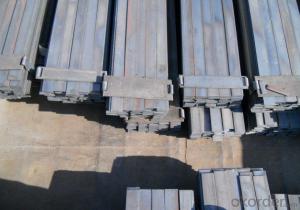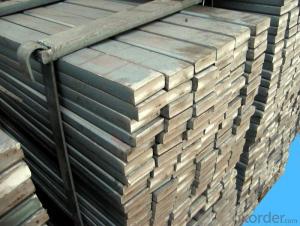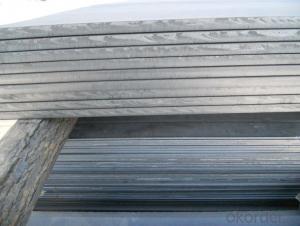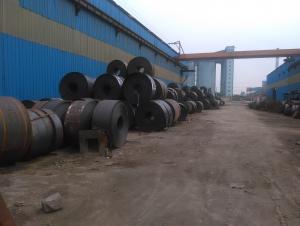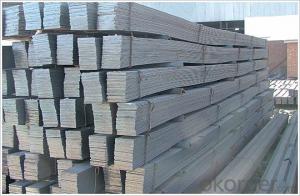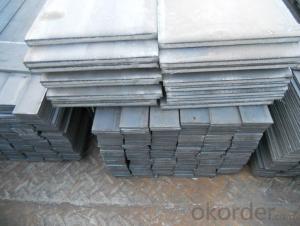Slit Cutting Flat Bar in Material Grade Q235B Steel Flat Bars
- Loading Port:
- Tianjin
- Payment Terms:
- TT or LC
- Min Order Qty:
- 25 m.t
- Supply Capability:
- 10000 m.t/month
OKorder Service Pledge
OKorder Financial Service
You Might Also Like
OKorder is offering high quality Slit Cutting Flat Bar at great prices with worldwide shipping. Our supplier is a world-class manufacturer of steel, with our products utilized the world over. OKorder annually supplies products to European, North American and Asian markets. We provide quotations within 24 hours of receiving an inquiry and guarantee competitive prices.
Product Applications:
Slit Cutting Flat Bars are ideal for structural applications and are widely used in the construction of buildings and bridges, and the manufacturing, petrochemical, and transportation industries.
Product Advantages:
OKorder's Slit Cutting Flats Barare durable, strong, and resist corrosion.
Main Product Features:
· Premium quality
· Prompt delivery & seaworthy packing (30 days after receiving deposit)
· Corrosion resistance
· Can be recycled and reused
· Mill test certification
· Professional Service
· Competitive pricing
Product Specifications:
Manufacture: Slit Cutting
Grade: Q195 – 235
Certificates: ISO, SGS, BV, CIQ
Length: 6m – 12m, as per customer request
Packaging: Export packing, nude packing, bundled
Chemical composition of Q235
Alloy No | Grade | Element(%) | ||||
C | Mn | S | P | Si | ||
Q235 | B | 0.12-0.20 | 0.3-0.7 | ≤0.045 | ≤0.045 | ≤0.3 |
Physical properties of Q235
Alloy No | Grade | Yielding strength point(Mpa) | Tensile strength (Mpa) | Elongation after fracture(%) | ||||||
Thickness (mm) | Thickness (mm) | |||||||||
≤16 | >16--40 | >40--60 | >60--100 | ≤16 | >16--40 | >40--60 | >60--100 | |||
≥ | ≥ | |||||||||
Q235 |
B |
235 |
225 |
215 |
205 |
375--500 |
26 |
25 |
24 |
23 |
Images:
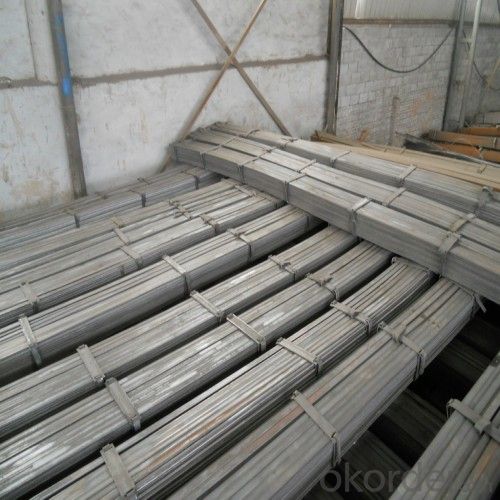
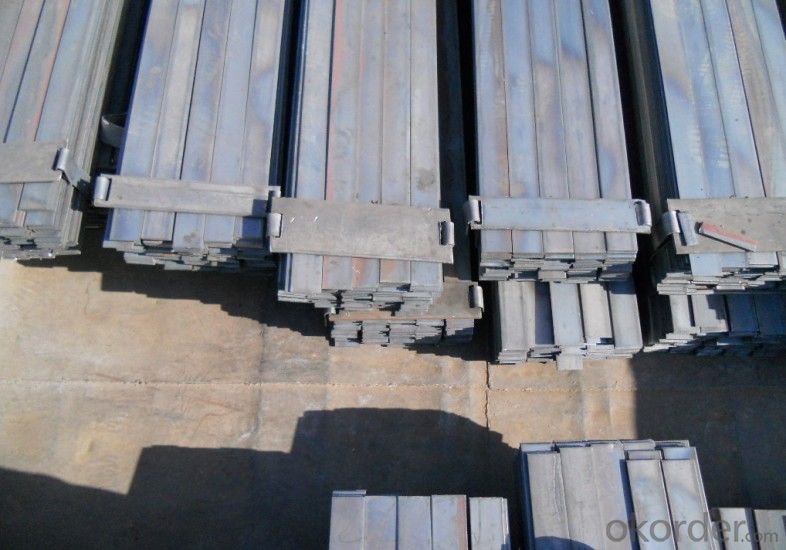
- Q:Are steel flat bars available in non-standard lengths?
- Yes, steel flat bars are available in non-standard lengths. While standard lengths for steel flat bars are typically 20 feet or 6 meters, many suppliers offer custom cutting services to provide the desired length. This allows customers to order steel flat bars in non-standard lengths according to their specific project requirements. By offering this flexibility, suppliers cater to a wide range of needs and ensure that customers receive the exact length they need for their applications.
- Q:What are the different types of surface defects that can occur in steel flat bars?
- Some common surface defects that can occur in steel flat bars include scratches, pits, cracks, and rust. Scratches are shallow marks on the surface, while pits are small depressions or cavities. Cracks are more severe, as they can extend through the thickness of the bar. Rust refers to the formation of iron oxide on the surface, which can weaken the steel if not treated. These defects can affect the appearance, integrity, and performance of the steel flat bars.
- Q:How do steel flat bars compare to other materials like aluminum or wood?
- Steel flat bars have several advantages over other materials like aluminum or wood. Firstly, steel is known for its strength and durability. Steel flat bars can withstand heavy loads and are less likely to warp or bend under pressure compared to aluminum or wood. This makes steel flat bars a popular choice for structural applications or for supporting heavy objects. Secondly, steel flat bars have excellent resistance to corrosion. Unlike aluminum, which can corrode over time, steel is highly resistant to rust and can maintain its integrity for a longer period. This makes steel flat bars suitable for outdoor applications or in environments with high moisture or humidity. Additionally, steel flat bars offer a high level of versatility. They can be easily welded, cut, or shaped to fit specific requirements. This flexibility in fabrication allows for a wide range of design possibilities, making steel flat bars a preferred choice for various construction projects. In terms of cost, steel flat bars are generally more affordable than aluminum. While wood may initially be cheaper, steel offers a longer lifespan, reducing the need for frequent replacements and maintenance costs. However, there are a few drawbacks to consider. Steel is significantly heavier than aluminum, which can make transportation and installation more challenging. Additionally, steel has a higher thermal conductivity, meaning it can conduct heat more readily than wood or aluminum. This can be a disadvantage in applications where insulation is a priority. In conclusion, steel flat bars offer superior strength, durability, and corrosion resistance compared to aluminum or wood. They are highly versatile, cost-effective, and suitable for a wide range of applications, making them a popular choice in various industries.
- Q:What are the different tolerances for steel flat bars?
- The tolerances for steel flat bars can vary depending on the specific requirements and industry standards. Generally, the most common tolerances for steel flat bars are determined by the American Society for Testing and Materials (ASTM) or the International Organization for Standardization (ISO). The tolerances for steel flat bars typically include dimensions such as width, thickness, and length. These dimensions are specified to ensure that the flat bars meet certain quality standards and can be used effectively in various applications. For width tolerances, the range can vary from as tight as ±0.005 inches (0.13 mm) to as loose as ±0.25 inches (6.35 mm). The specific tolerance is typically determined based on the required precision and application of the steel flat bar. For thickness tolerances, the range can vary from ±0.005 inches (0.13 mm) to ±0.25 inches (6.35 mm). Again, the specific tolerance depends on the desired precision and application. Length tolerances for steel flat bars can range from ±0.125 inches (3.18 mm) to ±1 inch (25.4 mm). This tolerance is crucial to ensure that the flat bars can be accurately cut to the desired length and fit properly in the intended application. It is important to note that these tolerances are just general guidelines and can vary based on the specific standards set by the manufacturer or customer requirements. It is always recommended to consult the relevant industry standards or specifications to determine the specific tolerances for steel flat bars in a particular application.
- Q:Are steel flat bars commonly used in the construction of industrial buildings?
- Yes, steel flat bars are commonly used in the construction of industrial buildings. Steel is a versatile and durable material that is widely used in construction due to its strength and ability to withstand heavy loads. Flat bars, in particular, are popular in industrial buildings because they offer a stable and even surface for structural support, as well as for framing and reinforcing purposes. They are often used as beams, columns, and braces, providing essential structural integrity to the building. Additionally, steel flat bars are easy to work with and can be customized to meet specific design requirements, making them a preferred choice in industrial construction projects.
- Q:Can steel flat bars be used for making storage shelves?
- Yes, steel flat bars can be used for making storage shelves. Steel flat bars are strong, durable, and able to support heavy loads, making them an ideal choice for storage shelves. They can be easily cut, welded, and shaped to create custom storage solutions. Additionally, steel flat bars are resistant to corrosion, which ensures that the shelves will maintain their structural integrity over time. Whether for industrial, commercial, or residential use, steel flat bars are a reliable and versatile option for making storage shelves.
- Q:How do steel flat bars contribute to the overall versatility of structures?
- The versatility of structures is enhanced by steel flat bars in several ways. Firstly, their flat and uniform shape allows for precise construction, making them easy to work with and manipulate. This versatility in shape and size enables steel flat bars to be utilized in various structural applications. Secondly, steel flat bars possess an excellent strength-to-weight ratio, making them lightweight yet capable of providing significant structural support. This quality makes them an ideal option for structures that require both strength and efficiency, such as bridges, buildings, and industrial frameworks. Additionally, steel's high tensile strength prevents bending and deformation, enhancing the durability and stability of structures. Moreover, steel flat bars can be easily joined together through welding or bolting, facilitating efficient connections and the creation of complex structures. This flexibility in joining methods allows architects and engineers to design structures that are not only strong and stable, but also visually pleasing. Furthermore, steel flat bars can be easily cut and shaped to fit specific design requirements, making them suitable for various architectural styles and functions. Whether it is for columns, beams, braces, or supports, steel flat bars can be customized to meet the unique demands of different construction projects. Additionally, steel flat bars exhibit excellent corrosion resistance, which is vital for structures exposed to harsh environmental conditions like coastal areas or industrial settings. This resistance to rust and deterioration ensures the longevity and reliability of structures, minimizing maintenance costs and extending their lifespan. In conclusion, steel flat bars contribute to the overall versatility of structures through their ease of workability, high strength-to-weight ratio, efficient joinability, customizable shape, and corrosion resistance. These attributes make steel flat bars the preferred choice for architects, engineers, and construction professionals, enabling them to create versatile, efficient, and durable structures.
- Q:What is the maximum load that steel flat bars can support?
- The maximum load that steel flat bars can support depends on various factors such as the dimensions of the bar, the type and grade of steel used, and the method of support. Therefore, it is difficult to provide a specific answer without more details.
- Q:How are steel flat bars used in the fabrication of furniture?
- Due to their versatility and strength, steel flat bars are commonly employed in furniture fabrication. These bars, typically crafted from carbon steel, possess exceptional durability and stability. The primary application of steel flat bars in furniture fabrication lies in the creation of robust frames and structures. By cutting and welding these bars together, furniture pieces like tables, chairs, and shelving units can be constructed with a sturdy skeleton. The flat and straight shape of steel flat bars allows for precise and clean lines during the construction process. Furthermore, steel flat bars serve to reinforce and support various components of furniture. They can be utilized as braces or brackets, offering additional stability and preventing bending or warping over time. Moreover, these bars can be bent or shaped to fit specific design requirements, making them highly adaptable for diverse furniture styles. In addition to their structural advantages, steel flat bars also contribute to the aesthetic appeal of furniture. They can be incorporated as decorative accents or trim, elevating the overall appearance and ambiance of the piece. Furthermore, steel flat bars can be finished in various ways, such as powder coating or painting, to match the desired color scheme or design theme. In summary, steel flat bars play an indispensable role in furniture fabrication, providing strength, stability, and versatility. Whether employed as a structural element or a decorative feature, these bars contribute to the overall durability and aesthetic allure of furniture pieces.
- Q:Are steel flat bars suitable for marine applications?
- Depending on the project's specific requirements, steel flat bars may be suitable for use in marine applications. Although steel is a strong and durable material, it can corrode in marine environments due to factors like moisture, saltwater, and air. To enhance the suitability of steel flat bars for marine use, they can be coated or treated with corrosion-resistant materials like galvanization or stainless steel. These coatings serve as a protective barrier that hinders or slows down the corrosion process. Moreover, the selection of steel grade is crucial, with marine-grade stainless steel (such as 316 or 316L) offering high resistance against corrosion in saltwater settings. Therefore, when choosing steel flat bars for marine applications, it is vital to consider the specific environmental conditions and opt for suitable materials and coatings to ensure long-lasting durability and optimal performance.
1. Manufacturer Overview |
|
|---|---|
| Location | |
| Year Established | |
| Annual Output Value | |
| Main Markets | |
| Company Certifications | |
2. Manufacturer Certificates |
|
|---|---|
| a) Certification Name | |
| Range | |
| Reference | |
| Validity Period | |
3. Manufacturer Capability |
|
|---|---|
| a)Trade Capacity | |
| Nearest Port | |
| Export Percentage | |
| No.of Employees in Trade Department | |
| Language Spoken: | |
| b)Factory Information | |
| Factory Size: | |
| No. of Production Lines | |
| Contract Manufacturing | |
| Product Price Range | |
Send your message to us
Slit Cutting Flat Bar in Material Grade Q235B Steel Flat Bars
- Loading Port:
- Tianjin
- Payment Terms:
- TT or LC
- Min Order Qty:
- 25 m.t
- Supply Capability:
- 10000 m.t/month
OKorder Service Pledge
OKorder Financial Service
Similar products
New products
Hot products
Hot Searches
Related keywords

